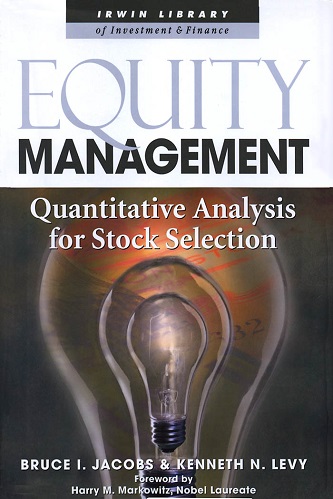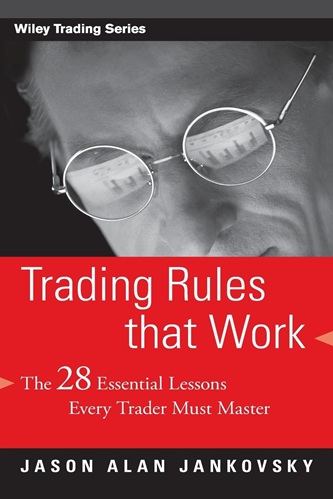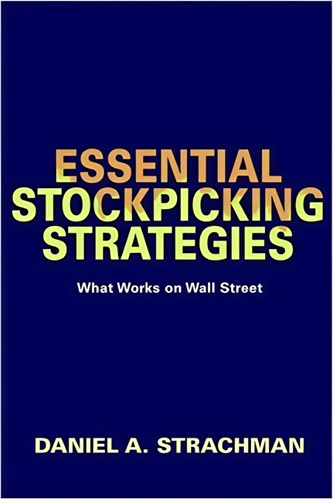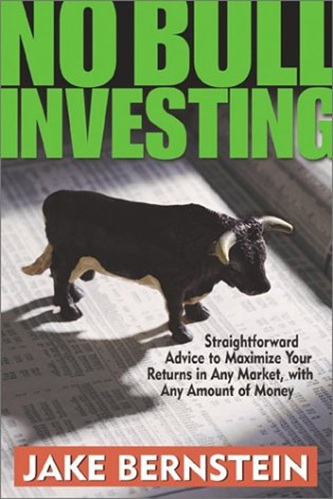Equity Management: Quantitative Analysis for Stock Selection By Bruce I. Jacobs, Kenneth N. Levy
$21.05
| Author(s) | , |
|---|---|
| Format |
|
| Pages |
416 |
| Publication Year |
2000 |
Equity Management provides new material to introduce, interpret, and integrate the pieces, with an introduction that provides an authoritative overview of the chapters. Important and innovative, it is destined to become the “Graham and Dodd” of quantitative equity investing.
Author’s Note:
For those readers unfamiliar with our articles, this book provides an introduction to the concepts that form the foundation of our approach to equity investing. For those of you who may have read these articles as they first appeared in print, the book provides an overall context within which the contributions of each article to our overall philosophy are clarified. In either case, we hope it will provide an enjoyable and valuable addition to your investment library.
The book groups the articles into three main sections. The articles in Part 1 focus primarily on security analysis in a complex market. The first two articles define complexity and discuss the importance of disentangling and purifying return-predictor relationships. The next three take a closer look at some of the anomalies that we have found to be exploitable, including departures from model-defined value, calendar effects, and the size effect. The last article in this section discusses some of the practical problems that arise in building predictors to include in a stock selection model.
In Part 2, the emphasis shifts from security selection to portfolio construction. The first two articles here investigate the benefits for both stock selection and portfolio construction of a “holistic” approach to the investment task, one that views the market from a broad, unified perspective, rather than focusing more narrowly on individual segments of the market. The third article discusses the limits of portfolio risk, arguing that there may be such a thing as a portfolio that is too safe. The fourth provides a case-study example of a portfolio construction process that aims to maximize the insights of our stock selection system by allowing portfolio weights to change aggressively as underlying economic and market conditions evolve.
The articles in Part 3 explore some recent developments in quantitative portfolio management. The first four articles concentrate on long-short portfolios, which can enhance the implementation of investment insights by enabling managers to sell short securities they expect to perform poorly. In these articles, we debunk some of the myths surrounding shorting and long-short portfolios, in particular, including the perceptions that long-short portfolios are necessarily riskier and costlier than long-only portfolios. We describe the mechanics of constructing market-neutral and “equitized” long-short portfolios, and the trading required to maintain them. And we introduce the concept of “integrated optimization” for maximizing the opportunities available from long-short management.
The final article in this section looks at how derivatives can be used in both long-only and long-short management to enhance performance. Derivatives have the potential to revolutionize investment management by allowing clients and managers to separate the security selection decision from the asset allocation decision.
Contents:
- The Complexity of the Stock Market
- Disentangling Equity Return Regularities: New Insights and Investment Opportunities
- On the Value of ‘Value
- Calendar Anomalies: Abnormal Returnast Calendar Turning Points
- Forecasting the Size Effect
- Earnings Estimates, Predictor Specification, and Measurement Error
- Engineering Portfolios: A Unified Approach
- The Law of One Alpha
- Residual Risk: How Much Is Too Much?
- High-Definition Style Rotation
- Long-Short Equity Investing
- 20 Myths about Long-Short
- The Long and Short on Long-Short
- Long-Short Portfolio Management: An Integrated Approach
- Alpha Transport with Derivatives
Equity Management: Quantitative Analysis for Stock Selection By Bruce I. Jacobs, Kenneth N. Levy pdf
6 reviews for Equity Management: Quantitative Analysis for Stock Selection By Bruce I. Jacobs, Kenneth N. Levy
Clear filtersOnly logged in customers who have purchased this product may leave a review.










Jaxson Dickerson (verified owner) –
A book that every serious student of stock selection and portfolio management should read and devour.
Scout James (verified owner) –
This insightful book demonstrates how the exceptional investor can profit by taking advantage of the cognitive errors of normal investors.
Myla Cruz (verified owner) –
An abundant source of ideas for any investor interested in winning stock selection techniques.
Legend Villarreal (verified owner) –
This book is great for people who want an overview of the opportunities available in numerical evaluation of stocks. However to say that this is a book on quantitative techniques is probably not the mest description. There is extensive use of regression analysis but more hard-core ‘quant’ people will probabliy be disappointed. It is clear that the book is written by investment professionals focusing a lot on traditional evaluations parameters such as P/E, P/B etc. Interesting points include purification of return signals, and an extensive discussion of long-short techniques.
Mallory Hayes (verified owner) –
Jacobs and Levy have assembled a body of work here centering on their stock picking techniques as well as their long-short portfolio construction techniques. Most of the chapters have their origins in various finance journals, though the articles themselves are not very heavy on mathematics. Overall, the book was interesting, though somewhat repititious. In retrospect I’d suggest that those familiar with long-short portfolios and the various market anomolies should just read chapter 2 about “Disentangling Equity Return Regularities” since that is where Jacobs & Levy’s original work is outlined.
Chapter 2 focuses on the use of regression analysis to “disentangle” various stock market anomalies. The authors claim that simple rules such as “Buy low-P/E stocks” are appealing, but oversimplify the true source of stock returns. For example, low P/E stocks tend to have higher rates of return, as do small-capitalization stocks. But if a small capitalization stocks also tend to have low P/E’s, then how much of their return is due to the low-P/E effect by itself, and how much is due to the small-capitalization effect by itself? Jacobs & Levy have done the analyses, and show which effects are genuine, and which effects are merely proxies for other effects. The effects that turn out to be the strongest when “disentangled” include low P/E, Earnings trend, Earnings Surprise, Residual Reversal, and Relative Strength.
The introductory chapters in the book make some interesting points. They argue that the stock market is not random, but then again it is also not simple. Although simple rules are appealing to humans, they oversimplify the complexity of the market. To gain an edge, one must use sophisticated, objective, multi-factor statistical computer models that capture the complex interactions in the market. Of course the authors are saying this to advocate the techniques they use, but nevertheless, they have some good points.
Finally, the second half of the book focuses on the construction of long-short portfolios, though there is not much fresh material here. They point out some of the logistical details of running a long-short portfolio, and give some examples. Also, they introduce the concept of “alpha-transport.” That is, one can construct a long-short market neutral portfolio, then by buying buy an index (using SP500 futures, for example) one “transports” the gains from the long-short portfolio onto the gains/losses of the index position. Thus, if the stock picking for the long-short portfolio is done correctly, the total portfolio will beat the index picked. To me, this seemed like an obvious technique; I’m surprised they decided to focus on it and give it a fancy name (“alpha transport”)
Overall, I found the book interesting, though somewhat repetitious. I was familiar with much of what was covered, however I did find that Chapter 2 was worth reading, since I wasn’t familiar with Jacobs & Levy’s work in detail.
Kelvin Le (verified owner) –
The Good: It is a collection of some of the great papers by the authors over the years that have appeared in Journal of Portfolio Mgt., Journal of Investing and the Financial Analysts Journal. If you do any work in quant equity management you should know and have these papers. Buy the book and save time hunting down the papers.
The Bad: It is a collection of some of the great papers by the authors over the years that have appeared in Journal of Portfolio Mgt., Journal of Investing and the Financial Analysts Journal. If you do any work in quant equity management you know and have these papers. The introductions and “new” material that ties it all together is not worth the expense. What sort of got under my skin is that none of the work has been updated or brought current, even by using appendicies. Since some of their most interesting quant work was published 12 years ago we have no updates as to how the factors are doing. This would have been a great value to this reader.
Overall its a great body of work but nothing new.